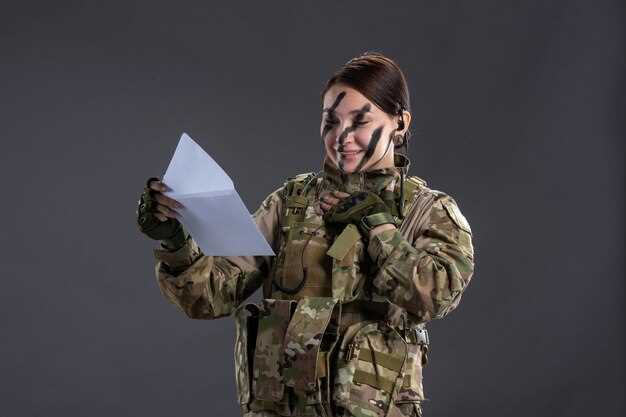Begin with evaluating your environment and activities to select the most suitable armor level. If you’re an avid outdoors enthusiast or engage in high-risk sports, opting for Level IIIA or higher is advisable due to its superior ballistic resistance.
Understand your specific needs. Each armor level offers different protection and mobility. Levels IIA and II provide basic protection, suitable for everyday scenarios where there’s low risk. For law enforcement professionals, Levels III and IV deliver heightened defense against rifles and other high-velocity threats, ensuring readiness in more demanding situations.
Consider comfort and weight alongside protection. Heavy armor can hinder mobility during extended wear. Lightweight options, while offering lower protection, may serve well in urban settings where agility matters. Strive for a balance that reflects your unique lifestyle and safety requirements.
Evaluate additional features such as breathability and fit. Properly fitted armor ensures optimum protection while allowing for ease of movement. Look for materials that provide both comfort and durability, which can enhance your overall experience while wearing the armor.
Your choice also hinges on potential threats in your area. Research local crime rates or consult with professionals to gain insights into applicable risks. This information will guide you toward the armor level that best aligns with your safety concerns.
By taking these steps, you’ll confidently choose armor that meets your specific needs, ensuring optimal safety and peace of mind.
Understanding Ballistic Protection Levels: A Quick Overview

To ensure safety and make informed decisions, familiarize yourself with the National Institute of Justice (NIJ) ballistic protection levels, which range from Level IIA to Level IV. Each level corresponds to specific threats and protection capabilities.
Ballistic Protection Levels Explained
Level IIA offers the lowest protection, designed to stop 9mm and .40 S&W rounds at lower velocities. This level is suitable for civilian applications where the risk involves handguns.
Level II provides more coverage, stopping 9mm and .357 Magnum rounds at higher velocities. Consider this option for law enforcement or personal defense in higher-risk situations.
Level IIIA protects against .357 SIG and .44 Magnum, suitable for those in heightened threat environments. This level is commonly used by law enforcement and security personnel.
Level III begins to protect against rifle threats, including 7.62 NATO. It is ideal for military use or individuals facing armed confrontations.
Level IV offers the highest protection, capable of stopping .30 caliber armor-piercing rounds. This level is necessary for military engagements or situations with significant risk from high-velocity projectiles.
Selecting the Appropriate Level
Assess your specific needs when choosing a level of ballistic protection. For general personal security, Levels IIA or II might suffice. If expecting potential confrontations, consider Levels IIIA or III. For military or high-risk law enforcement operations, Level IV is advisable.
Always remember to balance the protection level with mobility and comfort. Heavier armor may impede movement, so prioritize options that suit your lifestyle while ensuring adequate safety.
Stay informed about local laws and regulations regarding armor use. This knowledge facilitates responsible choices tailored to your unique requirements.
Identifying Your Specific Threat Environment for Armor Selection

Evaluate your surroundings to understand the types of threats you may face. Consider the geographical area, which can determine common risks associated with crime, conflict, or environmental hazards. For instance, urban settings often present higher risks of firearm violence, while rural areas may expose you to hunting accidents or wildlife encounters.
Examine the specific scenarios where you plan to utilize armor. If you frequently attend events where crowd dynamics are unpredictable, lightweight and flexible armor will enhance mobility. However, if your work involves law enforcement or military operations, prioritize level and coverage based on potential engagements you might encounter.
Assess the potential projectiles or weapons you might encounter. Different armor levels provide varying resistance against bullets, knives, or blunt force. Familiarize yourself with standards such as the NIJ (National Institute of Justice) ratings, which categorize armor into levels. For instance, level II and IIIA armor offers protection against handgun rounds, while level III and IV protect against higher-caliber ammunition.
Analyze any existing intelligence reports or crime statistics relevant to your area or profession. Current data can inform your armor decisions based on the most prevalent threats. Collaborate with local law enforcement or security experts to stay updated on emerging threats.
Lastly, consider personal factors such as comfort, weight, and fit of the armor. Ensuring proper fit not only enhances safety but also encourages wear, increasing the likelihood that you will utilize it regularly. Choose materials that suit your climate and activity levels; for example, breathable materials offer comfort in warmer environments, while heavier, more protective options may be necessary in high-risk situations.
Detailed Comparison of B4, B6, and B7 Armor Levels

Choosing between B4, B6, and B7 armor levels depends on your specific protection needs. Each level serves distinct requirements regarding ballistic resistance.
B4 Armor Level
B4 offers protection against 9mm and .44 Magnum rounds. It is lightweight and suitable for close-quarters situations, such as urban environments. Ideal users include:
- Security personnel
- Law enforcement agencies
- Civilians in high-risk areas
Consider B4 if you prioritize mobility and lightness while still needing protection from common handgun threats.
B6 Armor Level
B6 provides higher defense against 7.62mm NATO rounds and .357 Magnum projectiles. It strikes a balance between weight and protection, making it fit for various scenarios, including:
- Military personnel
- Private security details
- Individuals in conflict zones
This level is beneficial for those who require enhanced safety against both handguns and some rifle calibers without compromising too much on mobility.
B7 Armor Level
B7 offers maximum protection against armor-piercing 7.62mm and similar calibers. This level is bulkier but ensures safety in extreme environments. Suitable applications include:
- Military operations in hostile areas
- High-profile security roles
- Individuals exposed to elevated risks
Opt for B7 when your safety depends on countering serious ballistic threats; this level provides the strongest defense available in the B category.
In conclusion, assess the specific risks you face to determine the most adequate armor level between B4, B6, and B7. Each one is designed to meet different threat profiles and operational needs, making the right choice critical for effective protection.
How to Assess Personal Safety Needs in Various Situations
Evaluate your environment. Start by identifying potential threats in your daily activities. If you commute through high-crime areas, consider higher protection levels than you would in safer neighborhoods. Consider factors like time of day, crowds, and your mode of transport.
Personal Lifestyle Considerations
Analyze your lifestyle. If you frequently engage in nighttime activities or travel to unfamiliar places, you might need more robust armor options. Think about your profession as well–do you work in a security-related job or a field where you’re more susceptible to violence?
- Nightlife: Opt for higher protection if you regularly visit bars or clubs.
- Travel: For frequent travelers, pack armor that fits easily into your luggage.
- Work Environment: Assess if you face risks in your job and choose gear accordingly.
Specific Situations and Scenarios
Consider various scenarios. Tailor your armor choice based on specific situations you may encounter. For example, if attending protests or public demonstrations, lightweight and discreet options are beneficial.
- Home safety: Secure your home with alarms and assess personal protection during emergencies.
- Outdoor activities: Hiking in remote areas may require durable armor to shield against wildlife or accidents.
- Public gatherings: During large events, lightweight, flexible armor can provide comfort and safety.
Continuously review your safety needs. As your lifestyle or environment changes, be proactive in reassessing your armor requirements. Staying prepared ensures you remain secure in various situations.
Evaluating Weight vs. Protection: Finding Your Balance
Choose armor that balances weight and protection based on your specific activities. If mobility is critical, lighter armor might be the better option, while heavier armor provides superior protection but can hinder movement. Consider your physical capabilities and endurance; lighter armor allows for prolonged wear and agility, while heavier gear can lead to fatigue.
When selecting armor, evaluate the materials used. Advanced composites offer lightweight yet strong options that excel in various environments. Ensure the armor meets the necessary safety standards for your intended use. Try different levels of protection to understand which suits your activities best, assessing how it feels during movement.
Test various weight options while engaging in activities you plan to use the armor for. Pay attention to how the gear impacts your performance. This practical evaluation will clarify your priorities: do you need ultimate protection, or is maneuverability more critical? The right balance between weight and protection contributes significantly to your effectiveness in any situation.
Assess your environment too. Certain tasks, such as tactical operations, may demand higher protection due to potential threats, while other scenarios might allow for lighter gear without compromising your safety. Make your decision based on realistic assessments of threats and your comfort in wearability.
Finally, invest in ergonomic designs that distribute weight evenly. Well-fitted armor can reduce strain and enhance your overall experience. Prioritize finding the right balance to ensure safety and performance meet your unique needs.
Legal Considerations When Choosing Armor for Civil Use
Verify the legality of body armor in your state or country before making a purchase. Some regions impose restrictions on the type and level of armor civilians can own. Check local laws regarding ownership, sale, and use of body armor to ensure compliance.
Types of Armor and Legal Restrictions
Body armor is categorized into different classes, each with specific legal implications. For instance, certain types of armor designed to stop specific threats might be restricted or regulated under state laws. Usually, armor falls into the following categories:
| Armor Type | Legal Status | Comments |
|---|---|---|
| Soft Armor (Level IIA, II, IIIA) | Generally Legal | Most civilians can own this type without restrictions. |
| Hard Armor (Level III, IV) | Varies by Location | Some states may require permits or may prohibit civilian ownership. |
| Military Surplus Armor | Often Restricted | Check local laws; this may require permits. |
Purchasing Tips
Buy armor from reputable dealers who comply with local regulations. Ensure they provide clear information on the armor’s specifications and any pertinent legal guidelines. Keep records of your purchases and receipts, as this can help in case of legal inquiries.
Additionally, stay informed about any changes in laws regarding armor. Subscribe to local legal bulletins or join community forums that discuss self-defense and legal matters. This knowledge can safeguard your rights and ensure responsible ownership of body armor.
Common Misconceptions About Armor Levels and Their Capabilities
Armor levels cannot stop all types of ammunition. Many believe higher armor ratings provide full protection against any threat, but this is misleading. For instance, Level III armor is designed to stop certain rifle rounds but may not protect against all armor-piercing projectiles. Understanding the specific threats you may encounter is critical in selecting armor.
Weight of armor does not correlate directly with protection. People often assume that heavier armor guarantees better protection. While it often does offer enhanced performance, advancements in materials like Kevlar and ceramics provide lightweight options that can effectively stop ballistic threats. Researching the material and design will give you a clearer picture of protection without unnecessary bulk.
Higher levels equal better mobility.
This belief can lead to poor decisions regarding armor choice. Level IV armor offers the best protection but can significantly restrict movement due to its weight. Finding a balance between protection and mobility is vital for operational efficiency. Consider options that offer adequate protection while allowing ease of movement.
Level ratings are absolute.
Many assume that armor rated by standards such as NIJ offers the same performance across different manufacturers. Variability in design, material quality, and manufacturing standards means that two pieces of armor rated for the same level may perform differently in real-world situations. Always research specific products and consider user reviews and test results.
Armor is effective against all threats. Certain armors are tested against specific ballistic threats but may not stand up to knives or blunt force. Make sure to evaluate your particular threat environment and select armor accordingly, possibly even opting for multi-threat solutions.
Being informed helps challenge these misconceptions and strengthen your armor selection process. Always approach armor choices with a detailed understanding of your unique needs and the specific threats you might face.
Guidelines for Proper Maintenance and Care of Body Armor
Regularly inspect body armor for any signs of damage or wear. Check for cracks, dents, or fraying in the fabric. Any noticeable issues might compromise protection. If you find any concern, replace the armor without delay.
Clean your body armor after use. Hand wash it with mild soap and water. Avoid harsh chemicals, as they can damage the materials. Rinse thoroughly to remove all soap residue, which can cause degradation over time. For hard armor plates, use a damp cloth to wipe them down and ensure they are free of debris.
Store body armor in a cool, dry place. High temperatures and humidity can affect its integrity. Use a protective bag or sleeve to shield it from dust and physical abrasions. Avoid folding or compressing the armor; maintain its original shape for optimal performance.
Avoid direct sunlight exposure for extended periods. UV rays can degrade materials, making them less effective. If using the armor outdoors, consider using a cover to provide shade when not in use.
Keep body armor away from sharp objects and surfaces that could puncture or scratch it. Place it on a flat surface when not worn, and avoid stacking heavy items on top.
Follow the manufacturer’s recommendations for specific care instructions and replacement timelines. Many manufacturers provide guidelines for how long their armor should last under regular use. Staying informed helps ensure your protection remains intact.
Finally, conduct a maintenance check every few months, even if the armor isn’t frequently used. This practice guarantees your armor stays in peak condition and ready for action whenever required.
Video:
Choosing the Plate Carrier That’s Right For You – Spartan Armor Systems Body Armor 101
Choosing the Plate Carrier That’s Right For You – Spartan Armor Systems Body Armor 101 by Spartan Armor Systems 22,609 views 3 years ago 4 minutes, 47 seconds
Q&A:
What factors should I consider when choosing the right armor level?
When selecting the appropriate armor level, consider your specific needs, such as the type of threats you may encounter, the environment in which you operate, and your personal comfort. It’s also important to take into account the balance between protection and mobility. For example, higher levels of armor provide greater protection but can be heavier and less flexible. Evaluate what level of risk you are facing and choose an armor class that aligns with that threat level.
Can you explain the different armor levels available?
Armor levels are categorized by standards, typically set by organizations like the National Institute of Justice (NIJ). These levels range from IIA to IV, with level IIA offering protection against lower-caliber handguns, while level IV can stop high-powered rifle rounds. It’s crucial to understand these classifications, as they dictate the type of ammunition your armor can withstand. Higher levels generally indicate greater protection but also come with increased weight and cost.
What is the most common armor level for civilian use?
For civilian needs, armor level IIIA is often the most popular choice. This level provides sufficient protection against handguns and some shotgun blasts, making it suitable for personal defense situations. It offers a good balance between protection and wearability, allowing users to move freely while still feeling secure. However, each individual’s circumstances may vary, and it’s wise to assess personal threat levels before making a final decision.
How does armor weight impact my choice?
The weight of armor can significantly affect your decision. Heavier armor often means more protection, but it can also lead to fatigue and restrict movement. For users who require extended wear, such as law enforcement or security personnel, lighter armor may be preferable, despite offering less protection. Consider how long you will be wearing the armor and the nature of your activities when evaluating your options.
Should I buy new or used armor?
When deciding between new and used armor, consider the potential trade-offs. New armor typically comes with guarantees regarding its protective capabilities and lifespan. Used armor may be more affordable, but it might have wear and tear that could compromise its effectiveness. If opting for used gear, ensure it has not been subjected to any impact or damage and verify that it still meets safety standards before making a purchase.


